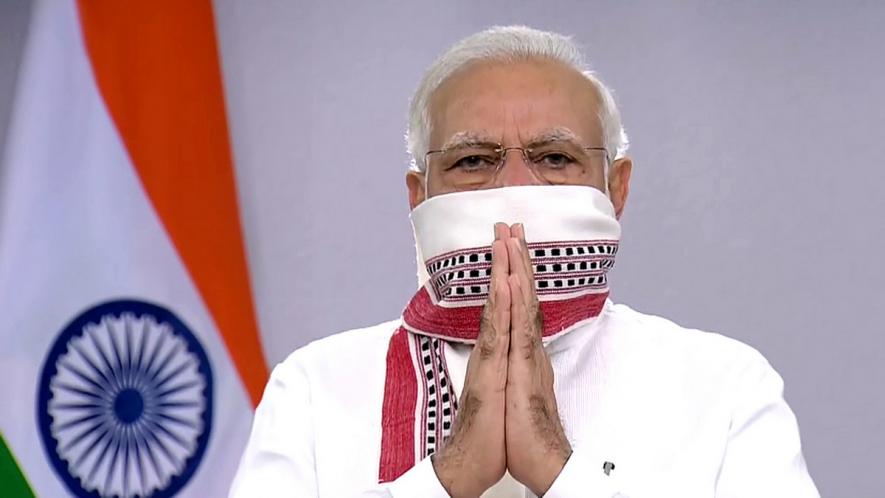How Modi’s ‘Stimulus’ Packages Will Destroy, Not Boost, India

Image Courtesy: The Print
For four successive days, Finance Minister Nirmala Sitharaman has announced various measures to boost the economy and – as she repeatedly says – to fulfil the Prime Minister’s dream of building a new, “self-reliant” India.
You may not have noticed, but these policy pronouncements have sharply divided India. Corporate tycoons, industry bodies, landlords and rich farmers, big traders, along with their apologists in the mainstream media, are hysterical in their approval of these measures. So is a large section of the middle class, which draws intellectual sustenance from TV talk shows. And, of course, foreign capital is pleased as punch.
But most trade unions, farmers and agricultural workers’ organisations, and progressive individuals, groups and peoples’ movements have been sharply critical of these measures. Despite the lockdown, protests are erupting across the country, including two protest days organised by Centre of Indian Trade Unions or CITU, and at a joint call by 10 central trade unions, another one is slated for May 22.
In the name of fighting the COVID-19 pandemic and reviving the sinking economy, the Narendra Modi regime has revealed a package of policies that openly sides with the rich, and declares a war on the poor. The reader may be astonished at this diagnosis: isn’t a whole lot of money being spent on working people and farmers? Migrant workers, fisher-folk, fruit and vegetable growers, poor women in remote villages – aren’t they and others like them getting some benefits? So, why this harsh criticism? Here’s why.
Will Farmers Benefit?
In the slew of measures announced on May 15, a complete overhaul of the agricultural produce trade has taken place. Sale and trade of key food items used to be controlled by law, because in a country the size of India, with its vast impoverished population, traders couldn’t be allowed to control the flow of essential cereals and other produce. They would manipulate prices and make profit out of the hunger and misery of people – indeed they still manage to do so. So, there were caps on prices and also on how much stock a trader could hold. All that has gone now.
This measure is being posed as liberation for farmers, but in effect it will mean a free for all in which the big traders will monopolise the market and ultimately determine prices and supply itself. Those with deep pockets – and this includes foreign companies – will out-compete local traders, and crush the farmers’ interests.
The infrastructure that is proposed to be set up, is the deal sweetener for these big private players in agri-commodities. Better marketing hubs, e-marketing, better connectivity – all this will help these lobbies.
So, the farmers who were struggling to sell their produce at remunerative prices and vainly demanding a support price that was 50% higher than cost of production, will now have to just wait and sell to whichever big trader comes and offers to buy up their standing crop, bribing them with advances and concessions. The assurance of a designated market place – despite all the corruption and perversions there – will now be gone, because the government has also declared that the law concerned will be changed and a new legal framework brought in.
In short, these measures will open up the agri-commodities sector to a free market regime, which will be integrated to the global markets, as is likely to happen in future. Indian farmers will sell their wheat or millets to global traders but at onerous terms, and no oversight.
The consumers – all of India – will no longer have the assurance of having adequate food stocks. It was these stocks that came in handy and saved millions of lives in the past two months. Once the whole system is privatised, only private companies may hold stocks. Otherwise, India will import foodgrain, like it did half a century ago.
Will Workers Benefit?
Last year, the Modi government had slashed corporate tax rates, thus freeing up the corporate sector from its social and economic responsibility. Since then, ‘ease of doing business’ has dominated the thinking of the Modi government and a range of measures – from easing credit to setting up help-funds, from buying out sinking corporates with public money to selling off profit-making public sector units – have been undertaken to boost the private sector. Indeed, not just to boost, but to help take over the entire economy.
What about workers and employees who produce all the profits for their employers? A series of changes in labour laws has denuded them of even the paltry protection they had against brutal exploitation. Work hours have been increased, wage fixation norms have been abandoned, safety and protection thrown to the winds, benefits have been cut, and collective bargaining or protest rights severely curtailed. These changes in laws may be routed through state governments but are actually the consensus of India’s bourgeoisie, represented by diverse political parties, barring the Left.
So much so, that over 140 million workers and employees lost their jobs by end of April and the Modi government has not lifted a tiny finger to help them out. In fact, most labour law changes have been foisted on the workers during this period of extreme distress.
A vast army of unemployed – as much as 27% of the workforce – has been fostered and allowed to grow, because it helps keep wages down. No matter that for millions this means a desperate struggle for just survival.
So, the policies, the stimulus packages notwithstanding, and despite the peanuts offered in terms of some kilograms of foodgrain, or a few rupees in the bank, the working people and the unemployed are today like 21st Century slaves, sullen but resigned to bondage and surrender.
Will Middle Class Benefit?
This is the section that has the biggest illusions about the ‘muscular’ and ‘decisive’ Modi regime. But it is already feeling the pinch with millions of white collar jobs lost, salaries cut and an uncertain future, with work from home the preferred option for employers because it saves them a lot of overhead expenses.
Privatisation of diverse sectors and invitation to predatory foreign capital creates more illusions, more division but ultimately disappoints most. In the ongoing pandemic, the shameful way in which the private sector has dealt with its employees – sending them off without pay, or just dismissing them – has yet again created deep distrust about privatisation even among sections that were its standard bearers.
Then, there is the impact of the economic policy itself – high unemployment, price volatility, booms and busts in sectors like real estate, and so on. All of this has soured the relationship between the Modi-led regime and the strident middle class. The lower sections of middle class are seemingly more and more disillusioned. It’s a different matter that all this may not yet reflect in political or electoral terms because of other factors like the absence of a viable opposition at present.
But, undoubtedly, the predatory nature of Modi’s economic policies, and its regressive social outlook have alienated large sections of the people. The pandemic is being used to consolidate the iron grip of big industrialists, traders and foreign interests by the government. But the same is hollowing out the social support spectrum of Modi. This will become evident in the coming days, even while grappling with COVID-19.
Get the latest reports & analysis with people's perspective on Protests, movements & deep analytical videos, discussions of the current affairs in your Telegram app. Subscribe to NewsClick's Telegram channel & get Real-Time updates on stories, as they get published on our website.
























